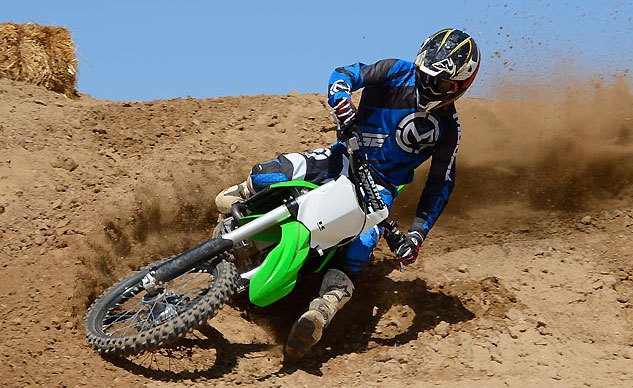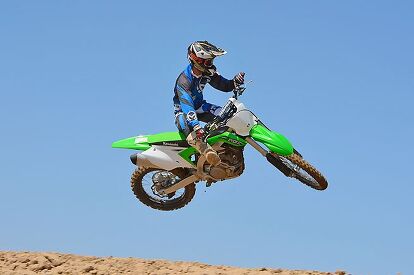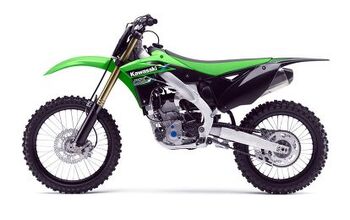2016 Kawasaki KX450F Review
Can the all-new KX450F return Kawasaki to its past glory?
Kawasaki ruled the big bike motocross class for the first part of the decade with its amazing KX450F, but times have changed, and in 2015 the big green machine wasn’t as dominant as it used to be.
2016 Kawasaki KX450F
| Engine | 19.0/20 |
| Suspension/Handling | 15.0/15 |
| Transmission/Clutch | 9.0/10 |
| Brakes | 8.0/10 |
| Instruments/Controls | 5.0/5 |
| Ergonomics/Comfort | 10.0/10 |
| Appearance/Quality | 10.0/10 |
| Desirability | 10.0/10 |
| Value | 9.0/10 |
| Overall Score | 95/100 |
With its last major redesign coming four years ago, and in the face of stiffer competition from the likes of KTM, Husqvarna and Yamaha, it was high time for the KX450F to be significantly updated, and Kawasaki has delivered that with the 2016 model. The new machine boasts a new engine that is lighter and more powerful, as well as a new chassis that is also lighter and slimmer. The net result of Kawasaki’s handiwork is a KX450 that is 7.5 lbs. lighter than the previous model and a whole lot more fun to ride.
Power was never a problem with the KX450F in the past, but Kawasaki’s engineers realized that there was plenty that could be done to make the engine quicker and lighter still. To that end, the KX’s fuel-injected DOHC four-stroke engine features entirely new cases that are shaped differently and feature lighter, thinner castings without sacrificing rigidity. While making the case change, Kawasaki also moved the oil pump from the left case to the right case and integrated the scavenge pump and the feed pump into one unit rather than keeping them separate, which saves space inside the smaller engine. The KX’s cylinder is also offset, pushed forward 8.5 mm to reduce friction by reducing piston to cylinder wall thrust, which frees up even more power.
The engine’s shape is already a dead giveaway that the 2016 KX450F is new, even though it retains the same 449cc displacement, 96.0 x 62.1mm bore and stroke and 12.8:1 compression ratio as the 2015 KX450F. Inside, however, the new motor also contains a significant number of redesigned parts. For instance, the cylinder head features redesigned intake ports that are straighter than before to provide a more direct shot of the incoming mixture into the combustion chamber.
That isn’t all. New 36mm titanium intake valves are employed to lighten the valvetrain, and Kawasaki says that the valves feature the same design parameters as the intake valves in its supersport engines, giving them a slimmer throat angle and reduced recesses. All four of the KX450F’s valves are bumped by new intake and exhaust cams that have been reshaped for a slimmer internal diameter, which provides a scant 0.5 oz. weight savings. Likewise, a new intake cam sprocket shaves an additional 0.7 oz. of reciprocating weight from the engine. In an attempt to gain better low-end power, Kawasaki engineers also revised the intake cam timing, advancing it 2°.
A new version of Kawasaki’s pioneering F1-style bridged-box bottom piston matches the new valve shapes. A reshaped crankshaft saves 1.9 oz. of weight, and the counterbalancer gears have also been lightened to reduce reciprocating weight by another 1.4 oz.
Kawasaki engineers also worked hard to maximize air flow into the engine and improve throttle response by completely redesigning the KX450F’s airbox, which now brings in fresh air through a pair of air intakes located at the back of the seat. All of the steel parts from the air box structure have been eliminated, which not only saves weight but also helps to reduce intake noise. Even greater noise reduction is attained via the KX450F’s exhaust system, which incorporates a new header design with a resonator that is designed to reduce sound emissions while boosting the engine’s low-end grunt.
The KX’s new 43mm Keihin throttle body is lighter and more compact than the previous version, with some of the weight savings coming via the elimination of the previous throttle linkage. Kawasaki’s DFI fuel-injection system boasts a revised fuel pump that facilitates the use of a lowered 1.66-gallon fuel tank to improve the bike’s center of gravity. Of course, the KX450F’s ECU retains Kawasaki first-in-class Launch Control feature, and the ignition curve can still be altered by plugging one of three distinct DFI couplers to suit the booming motor to match track conditions and/or riding style. The engine ECU is also fully programmable through Kawasaki’s accessory handheld KX FI Calibration Kit, which can store up to seven preset maps.
Our test ride took place at Sunrise MX Park in Adelanto, California, the newly redesigned track providing an excellent challenge for a newly redesigned motorcycle. Right off the bat, expert moto tester Ryan Abbatoye was impressed with the KX engine’s ability to churn out smooth bottom-end character that doesn’t immediately rip your arms off. However, you’d best be hanging on because the KX quickly vaults into a stout mid-range hit and pulls hard all the way to its rev limiter. The killer mid-range and long-legged top-end mean you won’t have to shift the KX450F’s slick five-speed transmission all that much. Abbatoye also noted that the KX has a much, much better-sounding exhaust note than the previous models despite it being a claimed 2db quieter than the old exhaust system – something Kawasakis have been criticized for in the past. Throttle response is also excellent regardless of rpm or engine load.
But what really impressed about the new KX450F is its handling. Previous-generation Kawasaki 450s have had a “steer with the rear” handling character in which the rider was forced to get on the throttle to help the machine carve a turn. The new KX450F is far less vague, delivering light and pinpoint accurate steering manners thanks to a newfound wealth of front-end traction. That’s because the 2016 KX450F features a completely new aluminum perimeter chassis, which is about 1 lb. lighter than the previous model and a whole lot narrower, thanks to its 6mm slimmer spars than the 2015’s frame. It could have been lighter still, but the KX450F’s subframe uses thicker wall material than in the past for improved strength. Even so, a revised aluminum swingarm drops another 7.8 oz. while also boasting improved rigidity via a larger pivot diameter. The overall chassis weight savings is 3.5 lbs., even with addition of a new forged downtube that is stiffer and certainly helps the chassis to be more reactive to steering input.
Boasting a 28° rake and 4.9 inches of trail, the chassis is designed to concentrate more of the KX’s 240-lb. wet weight forward to really help plant the front end or hold a line in a rut or through a high-speed sweeper, and it definitely does that. The best part is that this improved steering capability doesn’t come at the expense of straight-line stability at motocross speeds. Improved handling is definitely the 2016 KX450F’s strongest attribute.
“It steers really well,” Abbatoye said. “Previous KX450F’s were always stable, but they were more work to hustle through corners than this one is. That stability has always made Kawasakis great bikes for riding fast in the desert, so it would be interesting to get this one out in the desert at really high speeds to see if more weight on the front end has an effect on its stability.”
Abbatoye also mentioned that part of the KX450F’s handling feel can be attributed to its slimmer cockpit layout. The narrower frame spars really give the rider a lot more room to work with when scooting around on the machine to set it up for turns. Its seat is narrow but comfortable, and its flat profile makes sliding fore and aft no trouble at all. The slimmer sides also make it a little easier for shorter riders to deal with the KX’s lofty 37.8-inch seat height. On top of that, the KX450F’s ergonomics are more adjustable than most, with new footpegs that can be lowered 5mm to give taller riders more leg room as well as handlebar clamps that offer a total of 35mm of adjustment to dial-in the KX’s comfort for just about anyone.
Of all the improvements that Kawasaki has made to the KX450F, its suspension performance was the one that took the most time to get used to. Previous KX450Fs had a reputation for being stiff and unyielding over square-edged bumps, but Kawasaki has attempted to address this via revised settings in its Showa suspension components to give the bike a plusher ride. The KX’s 49mm Showa Separate Function Fork, Triple Air Chamber (SFF-TAC) unit boasts new low-friction seals and updated valving. It’s an impressive piece of suspension engineering. The left leg offers 22 positions of compression damping adjustment and 20 positions of rebound damping adjustment while further fine tuning is possible by adjusting the three air chambers in the right fork leg with the accessory 0-300 psi digital air pump that is supplied with the machine at the time of purchase.
Out back, the KX’s Uni-Trak rear suspension system has received a revised linkage ratio to work in concert with the new chassis. Its Showa piggyback reservoir shock features 19 positions of low-speed compression damping, four turns of high-speed compression damping and 19 positions of rebound damping. Typical of most off-road and motocross machines, the spring also features spring preload adjustability. For 2016, Kawasaki opted for a softer rear spring, going from 53 Newton-meters to 52 Newton-meters, again, for a plusher ride.
On the track, Abbatoye found the 2016 KX450F to be a lot plusher – in fact, a little too plush for a rider of his expert-level skills. It didn’t take long to realize that the big KX was blowing through its suspension travel rather easily at both ends when landing from big jumps and blasting through high-speed whoops. This tendency called for some adjustment.
To prevent the fork from bottoming, we opted to adjust the air pressures in the three chambers, an easy chore with Kawasaki’s special high-pressure pump, which is supplied to new KX owners. We went with Kawasaki’s recommended “Hard” pressure settings:
| Kawasaki’s “Standard” settings | Kawasaki’s Recommended “Hard” settings |
|---|---|
| Inner chamber: 174 psi (12 BAR) | Inner chamber: 189 psi (13 BAR) |
| Balance chamber: 203 psi (14 BAR) | Balance chamber: 218 psi (15 BAR) |
| Outer Chamber: 14.5 psi (1 BAR) | Outer Chamber: 14.5 psi (1 BAR) |
To stiffen up the shock action, we went out ¼ turn on the high-speed damping to help keep the rear wheel planted better and soak up bumps when accelerating out of a bumpy corner but added a few clicks of low-speed compression damping to slow the shock down over big hits. The combined suspension changes were a definite improvement, although Abbatoye commented that heavier riders or complete animals may want to be even more aggressive in firming up the KX’s suspension.
The new suspension settings allowed Abbatoye to attack the Sunrise track even harder, so he was glad that Kawasaki’s 270mm front and 240mm rear brakes and Nissin calipers do a great job of hauling the KX450F down from speed. The KX’s brakes deliver plenty of power and far better feel than some of the models we’ve tested lately.
If you’re a fan of green machines, you can also rejoice that the 2016 KX450F looks as good as it works, with all-new bodywork that gives the KX an almost anorexic look. Part of the slim appearance is due to new V-shaped radiators up front that allow the radiator shrouds to be moved in closer to the tank, and Abbatoye said that this is another contributing factor in the KX’s roomy layout.
“Bottom line, I like it a lot more than old one,” he said.
The 2016 KX450F is indeed an improved machine, and all of these improvements don’t put a substantial hurt on the customer’s wallet. At $8,799, the 2016 KX450F is only $100 more than the 2015 KX450F. That said, we expect to see a lot of green flowing into Kawasaki dealer coffers next year because we expect to see a lot of new green out on the nation’s motocross tracks.
| 2016 Kawasaki KX450F Specifications | |
|---|---|
| Engine | Liquid-cooled, fuel-injected, DOHC, four-stroke |
| Displacement | 449cc |
| Bore x Stroke | 96 x 62.1mm |
| Compression Ratio | 12.8:1 |
| Fuel System | DFI® with 43mm Keihin throttle body |
| Ignition | Digital DC-CDI |
| Transmission | 5-speed |
| Final Drive | Chain |
| Frame | Aluminum perimeter |
| Rake/Trail | 28°/4.9 inches |
| Fuel Capacity | 1.66 gallons |
| Front Suspension | 49mm Inverted Showa SFF-Air TAC Separate Function front Fork with Triple Air Chamber, DLC coated sliders, 22-position compression and 20-position rebound damping adjustment, 12.2 inches of travel |
| Rear Suspension | Uni-Trak linkage system and Showa shock, 19-position low-speed and 4-turns high-speed compression damping, 22-position rebound damping and fully adjustable spring preload, 12.4 inches of travel |
| Front Tire | 80/100-21 |
| Rear Tire | 120/80-19 |
| Front Brake | Single semi-floating 270mm Braking petal-style disc with dual-piston caliper |
| Rear Brake | Single 240mm Braking petal-style disc with single-piston caliper |
| Overall Length | 86.4 inches |
| Overall Width | 32.3 inches |
| Overall Height | 50.8 inches |
| Ground Clearance | 13.6 inches |
| Seat Height | 37.8 inches |
| Claimed Curb Weight | 239.6 lbs. |
| Wheelbase | 58.9 inches |
| Fuel Capacity | 1.66 gallons |
| Color Choices | Lime Green |
| MSRP | $8799 |
More by Scott Rousseau













































































Comments
Join the conversation